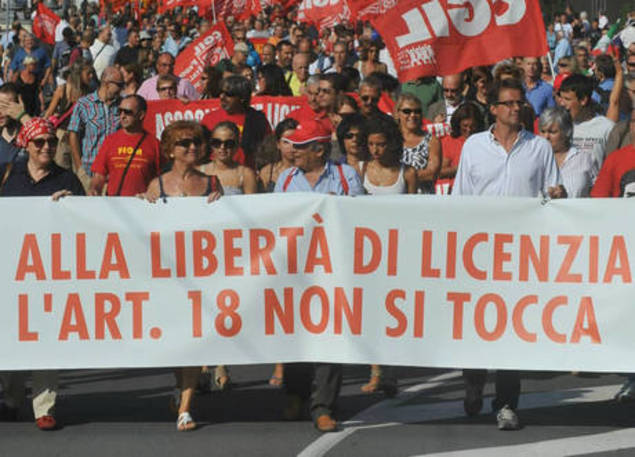


ROME – Last week’s joke circulating here was that two stodgy matrons in a café were chatting over cups of steaming cappuccino, presumably about their children or menus. A man eavesdrops as one lady leans toward the other to ask earnestly, “How goes the spread today?” The joke is that until now no Italian matron had ever heard of the spread. This week rings a change. Now that the spread is at least partly in check, the two busybodies are supposedly asking: “So what’s happening to Article 18 this week?”
For those who have managed to remain out of the loop, Article 18 is a paragraph is a labor law code that restricts the right of companies having more than fifteen employees from firing workers. (For more details on the visible and invisible effects of Article 18, see >> [2]. If a labor court determines unjust firing, the worker must be re-instated with full past pay. This protective legislation, adopted in the 1970s, on the one hand has guaranteed some workers from losing jobs by guaranteeing them the equivalent of tenure, but on the other hand has obliged manufacturers in trouble to keep workers on when the company risks going under. In addition, Article 18 has kept other workers from having jobs because, to dodge the law, some small factory owners carefully restrict their labor force to no more than fourteen. Another dodge, which the government is also fighting, is to hire workers on temporary contracts which leaves them completely unprotected.
Premier Mario Monti has made reform of this highly protective labor law a cornerstone of his government’s program, and this has brought him into conflict with a goodly chunk of the labor force, which is threatening massive retaliatory strikes, and bringing him into conflict with some of the politicians who support the crisis government. On Monday Monti, whose government is still firmly in the saddle since it came to power in November, leaves for what the Italian press has dubbed the “Monti road show,” a swing through Asia to hustle investments in Italy.
After weeks of meetings that brought the trade unions, the government and the manufacturers association Confindustria around a bargaining table, an eavesdropping journalist from the financial daily Il Sole-24 Ore swears that, after the latest meeting in a confusion of bodyguards and chauffeurs on Friday, the head of the leftist trade union CGIL (General Confederation of Italian Labor), he heard the head of the huge leftist trade union, Susanna Camusso, whisper to Monti, “Have a great trip to Asia, but you’re not going to tell them that they can just fire everybody, are you?” To which Monti reportedly replied in his usual courteous (and carefully ambiguous) manner, “That is not my intention.”
Labor market reform—that is, easing the employer’s right to dismiss workers for economic and disciplinary reasons—is the knottiest of Italian problems after corruption. The government on the one hand is pressing for labor reform, but on the other hand must keep itself in power with the votes of a broad coalition extending from right to left. In the case of Article l8, the road show at home can resemble a collision course. Monti’s support in Parliament comes from a heterogeneous coalition: Silvio Berlusconi’s rightist Freedom party (PdL); the Catholic-dominated centrist group headed by Pier Ferdinando Casini; and the Partito Democratico (PD), a catch-all leftist formation with a tradition of supporting the leftist trade unions, beginning with the once Communist-dominated CGIL, largest of the big three trade unions. Not surprisingly, the head of the PD, Pier Luigi Bersani, adamantly opposes the government’s reform project, even though Monti points out that only a tiny percentage (0.5%) of dismissal cases that come before a court involve Article l8. Ironically, when Bersani was then Premier Romano Prodi’s minister of economic development, he himself worked in favor of liberalization.
What is to be done? On Friday the government said firmly that its reform package remains on the table and will be presented as a draft bill later the Spring. This brought applause from the manufacturers because it was an important signal to the unions that the government is no longer willing to negotiate the reform bill, but will take it directly to Parliament. Passage is unlikely before summer, if at all; as has been pointed out repeatedly, there is conflict between the very concept of Italy and the new Europe, for the Italian constitution begins with the declaration that Italy is a republic founded upon labor, whereas Europe is a political fusion founded upon the free market.
Already on the credit side of the government ledger are a cautious pension reform, some liberalization of the economy and austerity measures. But although Monti and his labor minister, Elsa Fornero, speak earnestly of fostering job creation, the fact is that nothing has yet moved in that area. The result: the CGIL hunkers down all the more into a protective stance. Monti had hoped that this would be resolved before departing for his Asian tour, which will take in Tokyo, Boao to attend the Forum for Asia—the equivalent of the Davos World Economic Forum—and Astana.
Meantime, as Monti said Saturday, “Those politicians who like to go on about the GNP should show some patience. These are long-term operations, and the emergency is not yet over.”
Source URL: http://440468.6bgr9ubv.asia/magazine/focus/op-eds/article/eavesdropping-mr-montis-asian-road-show
Links
[1] http://440468.6bgr9ubv.asia/files/sciopero1332708498jpg
[2] http://www.ilsole24ore.com/art/english-version/2012-03-23/article-visible-invisible-effects-014619_PRN.shtml